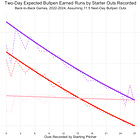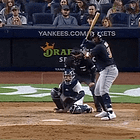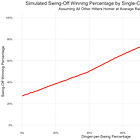Game Seven Was the Best of Baseball
The Dodgers won the World Series. We all won by experiencing it
Ten years ago last month, I went out for a beer with a friend who doesn’t follow baseball. Game Five of the 2015 ALDS between the Toronto Blue Jays and Texas Rangers flickered on a small TV behind the bar. I wasn’t invested in either team, so I was content to discreetly glance over every now and then for the first few innings.
Jeff Sullivan’s framing of what followed still sticks in my head a decade later. Say Satan were trying to get into baseball, and offered to spare your soul if you could show him what makes the game special in under an hour. Until that game, Sullivan posited, there was no clear right way to do it. But now you could just put on the seventh inning: the deflected throw back to the mound, the comedy of errors to load the bases, the most-iconic bat flip in the history of the game. “When it’s done, and the second bench-clearing incident is broken up,” he wrote, “you’ve got six minutes to take questions.”
I don’t recall when exactly I apologized to my friend and informed him that what was happening on the screen was too important to ignore. But I do remember that, by the time the stadium started rocking so hard that even the camera feed was shaking, my skeptical companion understood that he was witnessing something special.
The end of the 2025 MLB season felt like the baseball gods had stretched those six outs at Rogers Centre a decade prior into a full 11-inning game.
World Series Game Sevens (or is it Games Seven?) are definitionally high-stakes affairs. No matter what happens, the season ends that night. One team flies a championship banner forever. The other goes home to spend the next few months smarting over how close they came. Both sides leave it all out on the field. No one’s worried about saving their pitching staffs’ arms for tomorrow, because there is no tomorrow.
This pitching matchup alone made this Game Seven particularly special. In one corner was Max Scherzer, one of the greatest arms of his generation who was rumored to be considering retirement after the season, and who had just become the first pitcher in MLB history to start a postseason game for six different teams. His opponent was the best player in baseball, Shohei Ohtani, starting on three days’ rest — only his second time ever pitching on fewer than five days’ rest in an MLB game — seeking to add another Herculean feat to his lengthy list of precedent-shattering achievements.
Both Dave Roberts and John Schneider leaned into the spectacle, managing their pitching staffs as though winning were secondary to establishing compelling storylines for an eventual episode of 30 for 30. My research suggests that modern managers are generally too quick to pull their starters. But in a do-or-die game where the plan was to go to the bullpen early and no one on the staff was off-limits, having Ohtani face the top of the Blue Jays’ dangerous order a second time when he visibly wasn’t at his best felt more like attempted mythmaking than a reasoned strategy. Ditto for letting Scherzer, who had an 8.07 ERA over the previous two months and was left off Toronto’s roster altogether in the ALDS, pitch into the fifth. In the heat of Game Seven you use whatever pitcher you think gives you the best chance even if it’s not an ideal situation, but starters are accustomed to a certain routine, and before this weekend neither Shane Bieber nor Blake Snell had pitched out of the bullpen since 2019. Tyler Glasnow had thrown on back-to-back days exactly once in his MLB career, in 2018, before he came on in relief in both Games Six and Seven.
Then there’s Yoshinobu Yamamoto. Not only had he never pitched out of the bullpen since coming over from the Nippon Professional League (let alone with runners already on base) before he closed out the championship for the Dodgers and won World Series MVP honors on Saturday, but he did so after throwing six innings the night before — despite having never appeared on fewer than five days’ rest in his MLB career. Genius or madness? It worked out.
Not that the game would otherwise have been devoid of drama. Toronto objected to how much time Ohtani took to warm up between innings. Vladimir Guerrero Jr. and George Springer both thought the final pitch Guerrero saw in his first-inning at-bat was a ball, which led to a strike-’em-out-throw-’em-out double play (when Springer thought Guerrero had walked and stopped running before reaching second base) and therefore would have been one of the most consequential blown pitch calls in MLB history had it in fact not been in the strike zone. The benches cleared in the fourth inning after Andrés Giménez first tried to lean into a pitch, then actually got beaned. And for a fleeting moment it looked like the season might end on a walkoff replay review before the crew confirmed that Isaiah Kiner-Falefa was out at the plate on Miguel Rojas’ game-saving ninth-inning throw.
And yet, as in all the best games in any sport, the most-memorable moments came from what the players did on the field.
Bo Bichette suffered a knee injury in September and missed the Blue Jays’ first two postseason series. He joined the World Series roster having not appeared in a game in a month and half, and was initially available as only a part-time player. In the third inning, Ohtani intentionally walked Guerrero — to whom Bichette has been linked since their prospect days, as they were paired in fans’ minds as talented teammates with famous fathers — to face the hobbled slugger. Bichette stepped in against the best player in the world and fulfilled the dream of every hitter who’s ever been told, via an intentional walk to the previous batter, that the pitcher wasn’t afraid of them.
Yet Bichette’s was not the home run history will most remember. In the top of the ninth, with Toronto two outs away from a championship, Miguel Rojas stepped to the plate against Jeff Hoffman. Rojas was the Los Angeles’ utility infielder and started only four of their 17 postseason games. Fans were shocked that the Dodgers didn’t pinch hit for the light-hitting Rojas in such a crucial spot. But Dave Roberts knows a thing or two about role players playing the hero in big games. And Rojas tied the game with one of the most-stunning swings in the history of the sport.
In a game full of web gems — the Jays would have lost long before the 11th inning if not for the defensive heroics of Guerrero and Daulton Varsho — the one fans are talking about most also came from Rojas. With the game tied and the bases loaded with one out in the ninth, Rojas snagged a grounder off Varsho’s bat and somehow willed the ball home, his off-balance throw just beating Kiner-Falefa’s (questionable) slide at the plate and saving the Dodgers’ season.
But the most-jawdropping play of the game — nay, the season — came a pitch later. Andy Pages was the Dodgers’ starting center fielder for most of the year, but he and his 4-for-50 playoff batting line found themselves benched for Game Seven. He entered the game in the ninth as a rare mid-inning defensive replacement. Five pitches later, Ernie Clement hit a deep fly ball to left-center, well behind where both Pages and left fielder Kiké Hernández were positioned. The ball appeared to sail over Hernández’ head for a World Series walkoff. Until Pages barreled onscreen, running through both 121 feet of turf and Hernández to make the leaping catch to send the game to extras.
If this were a sleepy midweek matchup between two cellar-dwelling teams in June, it would be in the conversation for the best play of the year. Pages did it with the bases loaded, two outs, and the score tied in the bottom of the ninth of Game Seven of the World Series. And this game was so bananas that it almost felt like an afterthought in the postgame coverage.
The game’s eventual ending in the 11th inning was a rushed denouement, as Alejandro Kirk’s weak grounder turned into a championship-clinching double play for the Dodgers so quickly that it was hard to register it in real time. But this game had already made history one batter earlier, when Addison Barger stepped up with a runner on third and one out and the Blue Jays down by a run. Yamamoto’s first delivery was a Golden Pitch: a chance for Barger to end the game in a championship for either the Dodgers (if he hit into a double play) or the Blue Jays (if he hit a home run). This was just the ninth game in MLB history in which a single swing could have determined the World Series in either direction.
Maybe the best way to sum up how exciting this game was is this: Among MLB.com’s postgame coverage, a team of writers compiled a ranked list of the game’s biggest plays. Will Smith’s tiebreaking 11th-inning home run that won the World Series for the Dodgers — the sort of thing normally that would be the singular defining moment of the whole postseason — didn’t crack the top five.
Or maybe it’s that the chaotic 18-inning marathon that was Game Three somehow turned out not to be the highlight of the series.
Or maybe it’s that I’m nearly 1,700 words into writing about this game and it hasn’t occurred to me to mention the final score.
When someone tells me they don’t understand my passion for cheesesteaks, follow-up questions usually reveal that they haven’t tried a good one. Either they’ve never been to Philadelphia and don’t realize that cheesesteaks elsewhere truly are not the same, or their only experience was at the tourist traps of Pat’s and Geno’s. If I had a dollar for every skeptic whose face has lit up (from both happiness and fluorescent cheese product) when I took them for a legit steak — well, I could certainly buy you lunch.
Game Seven of the 2025 World Series is the baseball equivalent of a whiz with at Tony & Nick’s. It’s what you would show a demon if you had a full game to win him over to save your soul.
If you could watch those last few innings and not feel your heart soar or fall with every swing, then fine: I will never be able to convince you that baseball isn’t boring. But based on how many people I’ve heard from in the last couple days who found themselves drawn in by one of the best games of all time, I’d take my chances. “I now understand the love of baseball,” one relative told me. “Remember when I was looking for a team?” asked another who had tuned into the Blue Jays’ run in hopes of rekindling his dormant passion for the game. “Well I’ve got one now!” From total strangers, too: “Even though I find baseball exceedingly dull,” someone replied to me on social media, “I was glued to the TV.”
For my entire adult life, baseball people have wrung their hands about regrowing the sport’s popularity. They’ve tried rule changes, some of which have improved the game, and some of which haven’t. They’ve tried new ways to showcase the league’s stars. They’ve tried hiring broadcasters who constantly complain about how much better baseball used to be on national TV. (Oddly, this one hasn’t worked.) Yet what this World Series makes clear is that the best selling point for the sport is the game itself, what Dick Cramer called a “soap opera that lends itself to probabilistic thinking,” the distinct blend of chess and athletic prowess that unfolded before our eyes while a curmudgeonly commentator bemoaned that teams don’t bunt as much anymore.
Seven months ago, while swept up in the ubiquitous optimism of Opening Day, I recounted one of my saddest childhood memories: playing for a coach who did his darnedest to suck the joy of baseball out of his roster of nine-year-olds. As an alternative to the Coach Kevins of the world, and in the spirit of the time of year when the first pop of a ball in a mitt fills so many hearts with joy, I proposed a mission statement for baseball fans: “To maintain this magical feeling for as long as possible.” With apologies to Toronto fans, by sending us into the offseason with an exhilarating instant-classic Game Seven, the Dodgers and Blue Jays have done just that.
Pitchers and catchers report in 100 days.






Thanks for writing and sharing this article. Very enjoyable, good writing, and it helps me appreciate a great game even more.
I still can't believe the contingencies that went into the Andy Pages catch. There's no way Kike or Edman would have made the play. Roberts's move saved the game and won them the World Series, and might be the best in-game manager's decision of all time. Who changes centerfielders mid-inning and then has that happen?
(And next year, I hope you're writing about a great Phillies World Series, not just great Philly cheesesteaks.)
Hear, hear! One of the great playoff series ever capped off by one of the single greatest games in baseball history. Amazing what humans can accomplish sometimes.